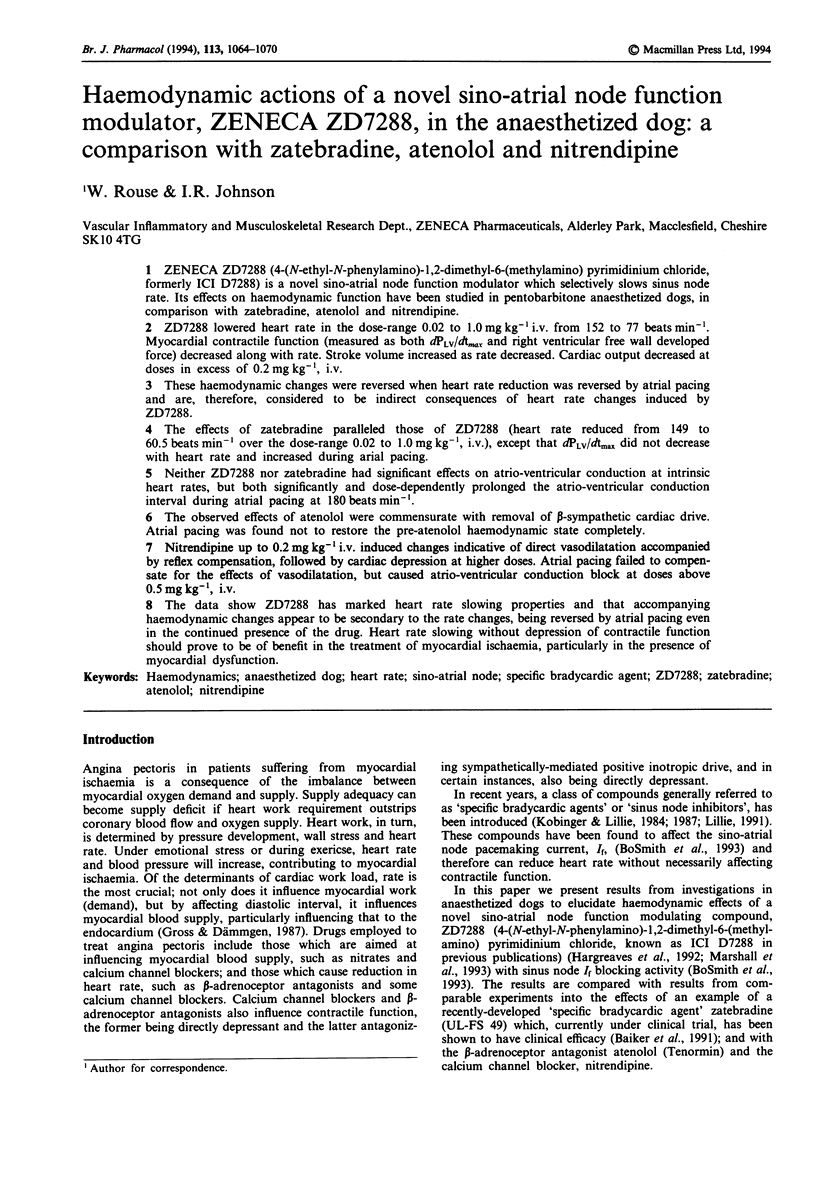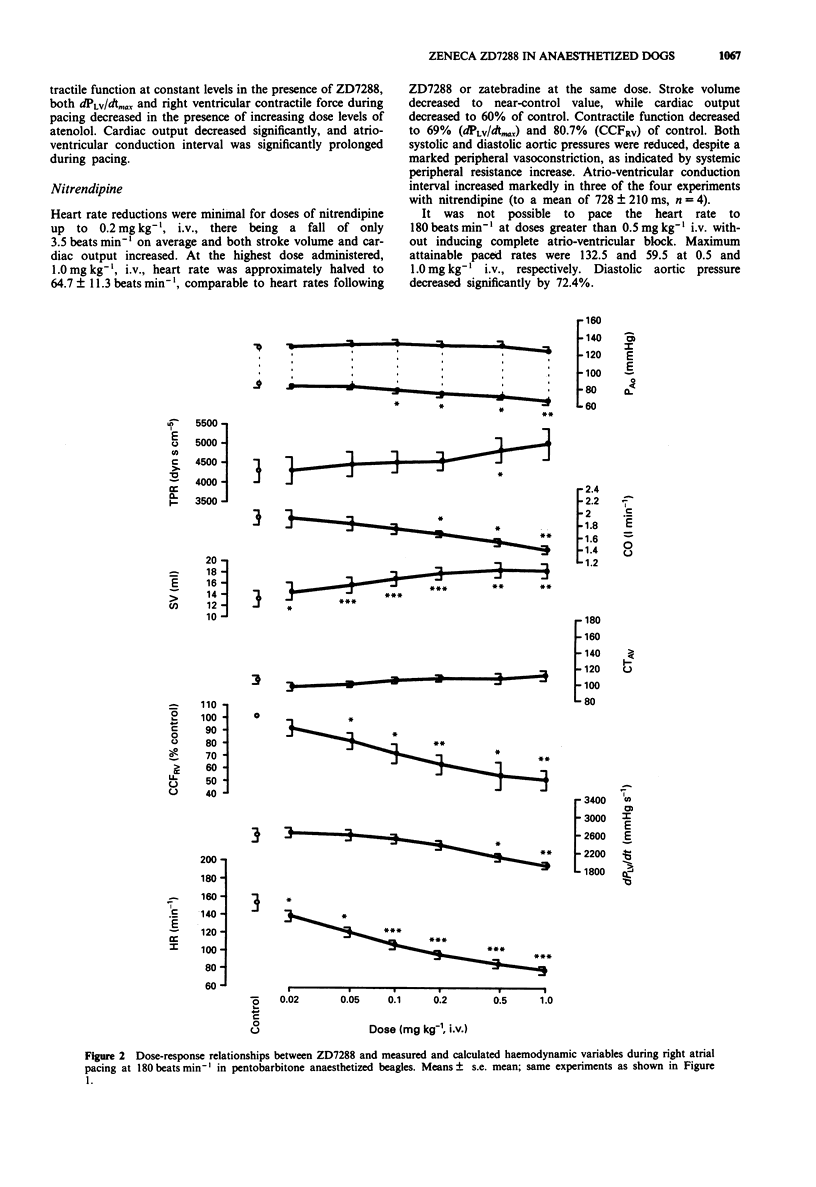Abstract
1. ZENECA ZD7288 (4-(N-ethyl-N-phenylamino)-1,2-dimethyl-6-(methylamino) pyrimidinium chloride, formerly ICI D7288) is a novel sino-atrial node function modulator which selectively slows sinus node rate. Its effects on haemodynamic function have been studied in pentobarbitone anaesthetized dogs, in comparison with zatebradine, atenolol and nitrendipine. 2. ZD7288 lowered heart rate in the dose-range 0.02 to 1.0 mg kg-1 i.v. from 152 to 77 beats min-1. Myocardial contractile function (measured as both dPLV/dtmax and right ventricular free wall developed force) decreased along with rate. Stroke volume increased as rate decreased. Cardiac output decreased at doses in excess of 0.2 mg kg-1, i.v. 3. These haemodynamic changes were reversed when heart rate reduction was reversed by atrial pacing and are, therefore, considered to be indirect consequences of heart rate changes induced by ZD7288. 4. The effects of zatebradine paralleled those of ZD7288 (heart rate reduced from 149 to 60.5 beats min-1 over the dose-range 0.02 to 1.0 mg kg-1, i.v.), except that dPLV/dtmax did not decrease with heart rate and increased during arial pacing. 5. Neither ZD7288 nor zatebradine had significant effects on atrio-ventricular conduction at intrinsic heart rates, but both significantly and dose-dependently prolonged the atrio-ventricular conduction interval during atrial pacing at 180 beats min-1. 6. The observed effects of atenolol were commensurate with removal of beta-sympathetic cardiac drive. Atrial pacing was found not to restore the pre-atenolol heamodynamic state completely.(ABSTRACT TRUNCATED AT 250 WORDS)
Full text
PDF






Selected References
These references are in PubMed. This may not be the complete list of references from this article.
- BoSmith R. E., Briggs I., Sturgess N. C. Inhibitory actions of ZENECA ZD7288 on whole-cell hyperpolarization activated inward current (If) in guinea-pig dissociated sinoatrial node cells. Br J Pharmacol. 1993 Sep;110(1):343–349. doi: 10.1111/j.1476-5381.1993.tb13815.x. [DOI] [PMC free article] [PubMed] [Google Scholar]
- Falotico R., Haertlein B. J., Lakas-Weiss C. S., Salata J. J., Tobia A. J. Positive inotropic and hemodynamic properties of flosequinan, a new vasodilator, and a sulfone metabolite. J Cardiovasc Pharmacol. 1989 Sep;14(3):412–418. doi: 10.1097/00005344-198909000-00009. [DOI] [PubMed] [Google Scholar]
- Furnival C. M., Linden R. J., Snow H. M. The inotropic and chronotropic effects of catecholamines on the dog heart. J Physiol. 1971 Apr;214(1):15–28. doi: 10.1113/jphysiol.1971.sp009416. [DOI] [PMC free article] [PubMed] [Google Scholar]
- Gross G. J., Daemmgen J. W. Effects of bradycardic agents on ischaemic myocardium and perfusion in anesthetized dogs. Eur Heart J. 1987 Dec;8 (Suppl 50):69–74. doi: 10.1093/eurheartj/8.suppl_l.69. [DOI] [PubMed] [Google Scholar]
- Johnston W. E., Vinten-Johansen J., Tommasi E., Little W. C. ULFS-49 causes bradycardia without decreasing right ventricular systolic and diastolic performance. J Cardiovasc Pharmacol. 1991 Oct;18(4):528–534. doi: 10.1097/00005344-199110000-00008. [DOI] [PubMed] [Google Scholar]
- Kobinger W., Lillie C. Cardiovascular characterization of UL-FS 49, 1,3,4,5-tetrahydro-7,8-dimethoxy-3-[3-][2-(3,4-dimethoxyphenyl)ethyl] methylimino]propyl]-2H-3-benzazepin-2-on hydrochloride, a new "specific bradycardic agent". Eur J Pharmacol. 1984 Sep 3;104(1-2):9–18. doi: 10.1016/0014-2999(84)90363-7. [DOI] [PubMed] [Google Scholar]
- Kobinger W., Lillie C. Specific bradycardic agents--a novel pharmacological class? Eur Heart J. 1987 Dec;8 (Suppl 50):7–15. doi: 10.1093/eurheartj/8.suppl_l.7. [DOI] [PubMed] [Google Scholar]
- Marshall P. W., Rouse W., Briggs I., Hargreaves R. B., Mills S. D., McLoughlin B. J. ICI D7288, a novel sinoatrial node modulator. J Cardiovasc Pharmacol. 1993 Jun;21(6):902–906. doi: 10.1097/00005344-199306000-00008. [DOI] [PubMed] [Google Scholar]
- Raberger G., Krumpl G., Schneider W. Effects of the bradycardic agent UL-FS 49 on exercise-induced regional contractile dysfunction in dogs. Int J Cardiol. 1987 Mar;14(3):343–354. doi: 10.1016/0167-5273(87)90205-1. [DOI] [PubMed] [Google Scholar]
- Raberger G., Krumpl G., Schneider W., Mayer N. Effects of specific bradycardic agents on exercise-induced regional myocardial dysfunction in dogs. Eur Heart J. 1987 Dec;8 (Suppl 50):53–59. doi: 10.1093/eurheartj/8.suppl_l.53. [DOI] [PubMed] [Google Scholar]
- van Woerkens L. J., van der Giessen W. J., Verdouw P. D. The selective bradycardic effects of zatebradine (UL-FS 49) do not adversely affect left ventricular function in conscious pigs with chronic coronary artery occlusion. Cardiovasc Drugs Ther. 1992 Feb;6(1):59–65. doi: 10.1007/BF00050918. [DOI] [PubMed] [Google Scholar]


